Abstract
Somatosensory evoked potentials (SEPs) were used to evaluate possible subclinical impairment of the nervous system due to occupational exposure to toluene and styrene. A group of 36 rotogravure printers with severe exposure to toluene, 20 workers with severe exposure to styrene in a glass laminate manufacturing plant, and a comparison group of healthy subjects were studied. The severity of exposure was documented by measurements of toluene and styrene concentrations in breathing zone air, by hippuric acid concentration in urine in the group exposed to toluene, and by urinary mandelic acid concentration in the group exposed to styrene. Somatosensory evoked potentials were measured by stimulation of the median nerve at the wrist and the tibial nerve at the ankle. Peripheral conduction velocities (CVs) in both extremities and central conduction time (CCT) after tibial nerve stimulation were significantly decreased in both exposed groups. Significantly prolonged latencies of peripheral and cortical SEPs to median nerve stimulation as well as cortical SEPs to tibial nerve stimulation were found in workers exposed to styrene. Some abnormalities in SEPs at peripheral or spinal and cortical levels were found in eight workers exposed to toluene and six workers exposed to styrene. Of these, in three workers exposed to toluene and two to styrene increased CCT and delayed latencies of cortical responses at normal conduction values in the periphery were found. A trend for increased frequency of abnormal SEPs with duration of exposure to toluene and styrene and alcohol abuse was found. Abnormalities in SEPs in the exposed groups are most probably of multifactorial origin. Central SEP abnormalities in both exposed groups could indicate early signs of subclinical dysfunction at spinal and cortical levels and could be due to toluene or styrene exposure probably potentiated by alcohol consumption in the group exposed to toluene.
Full text
PDF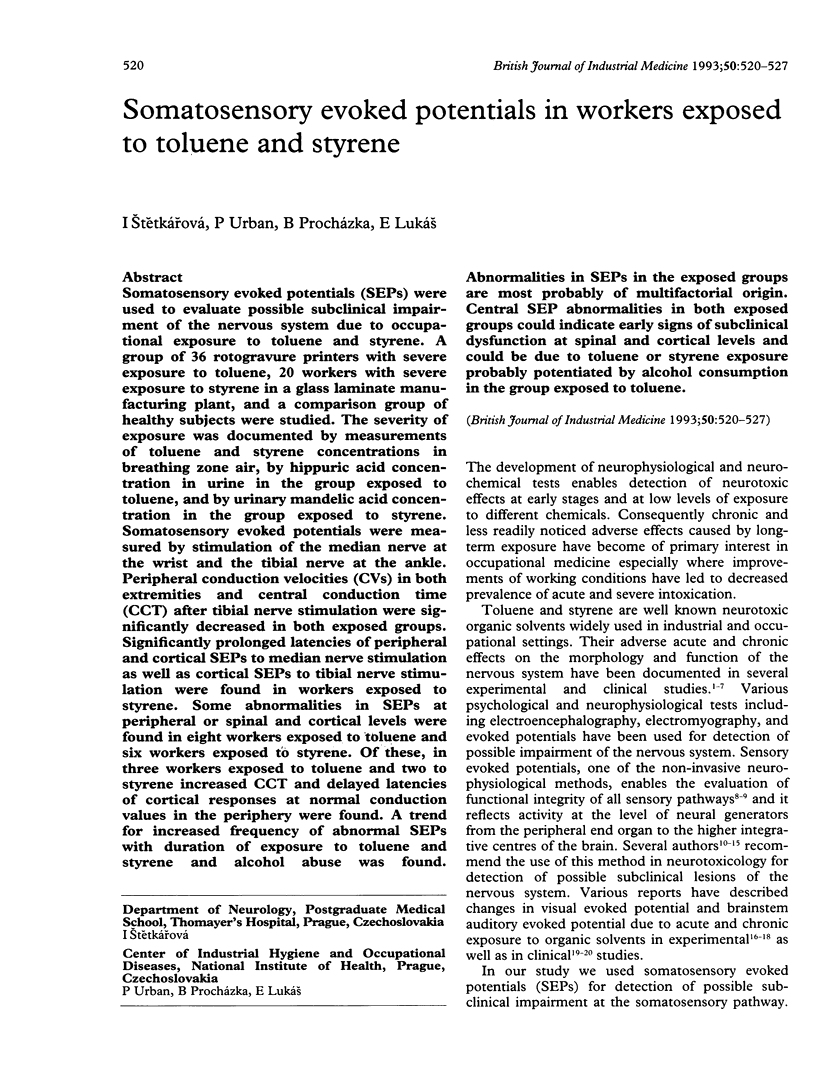
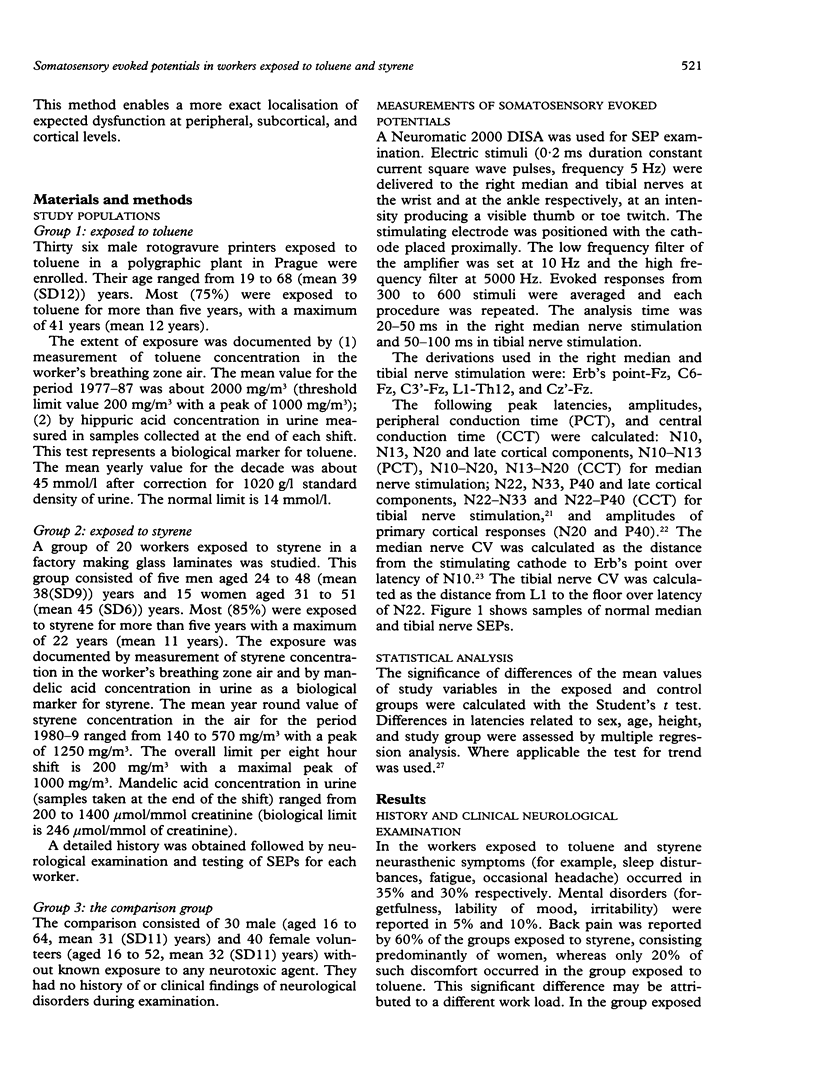
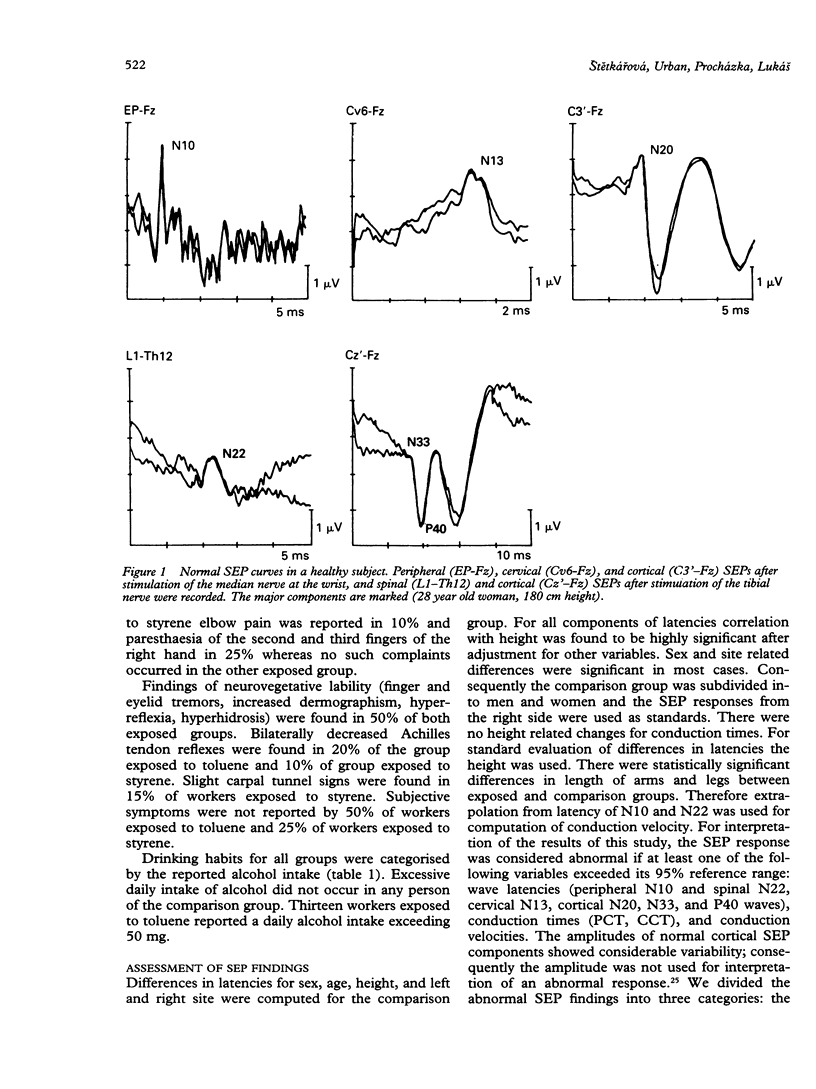
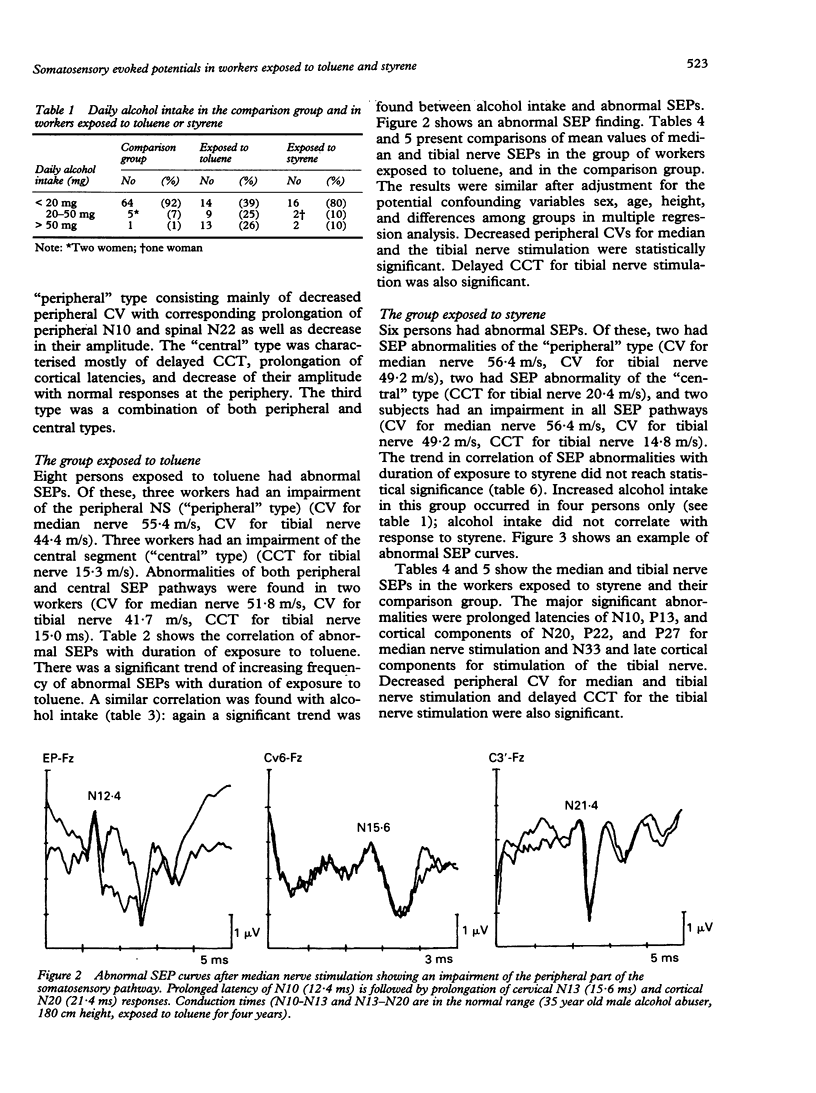
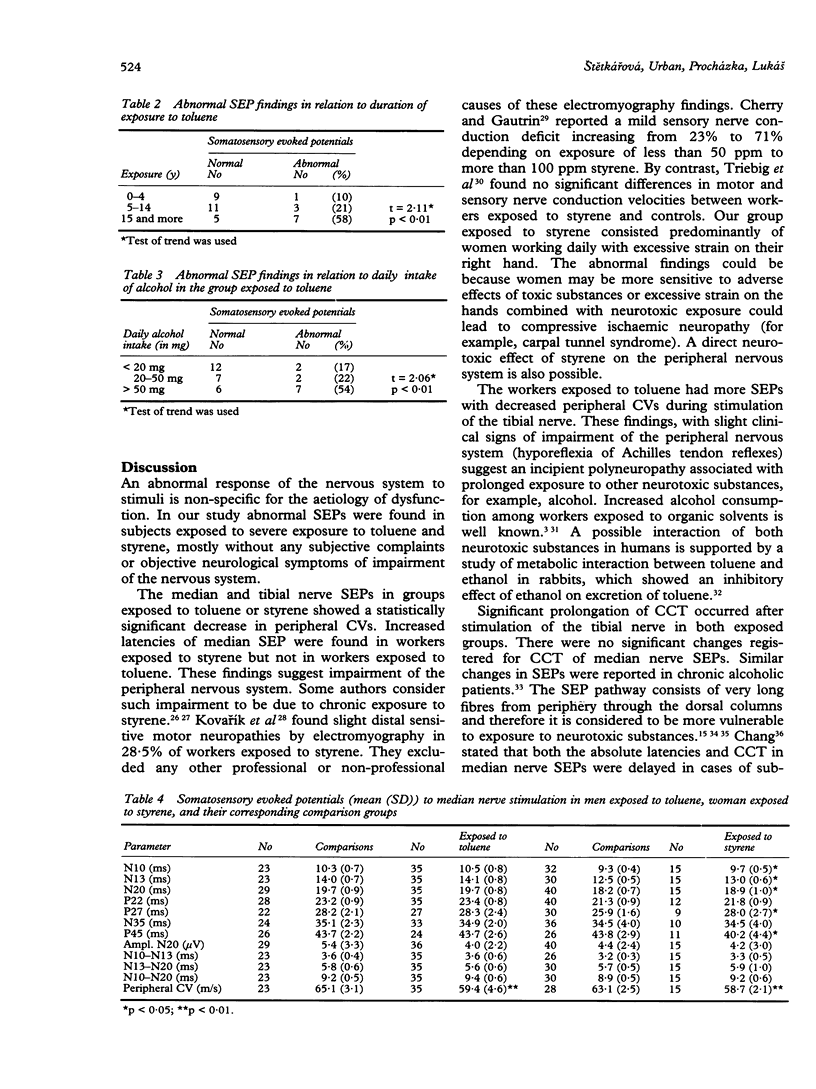
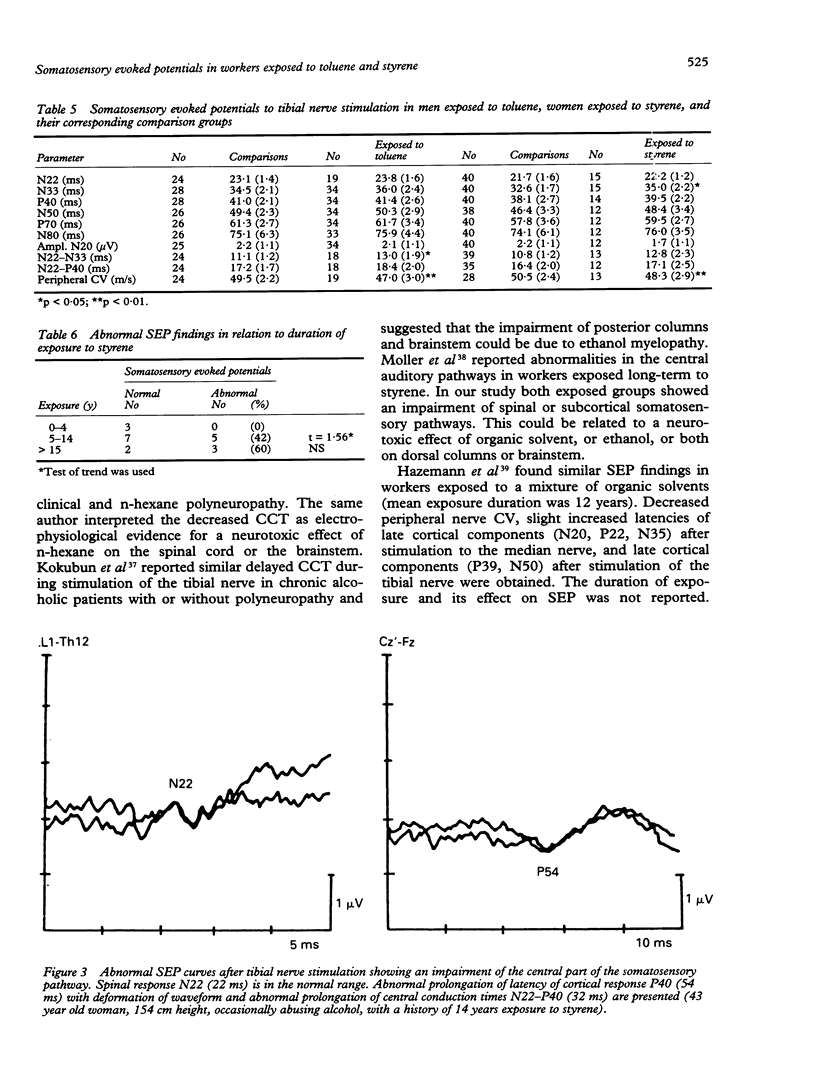
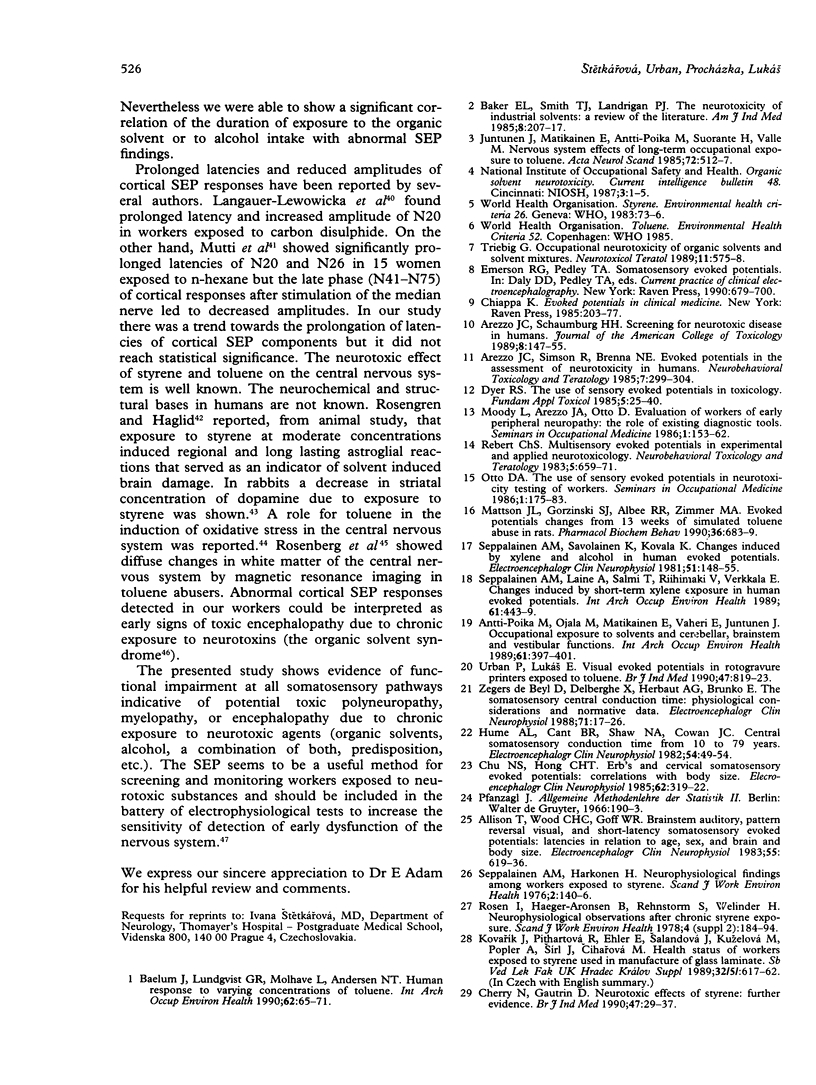
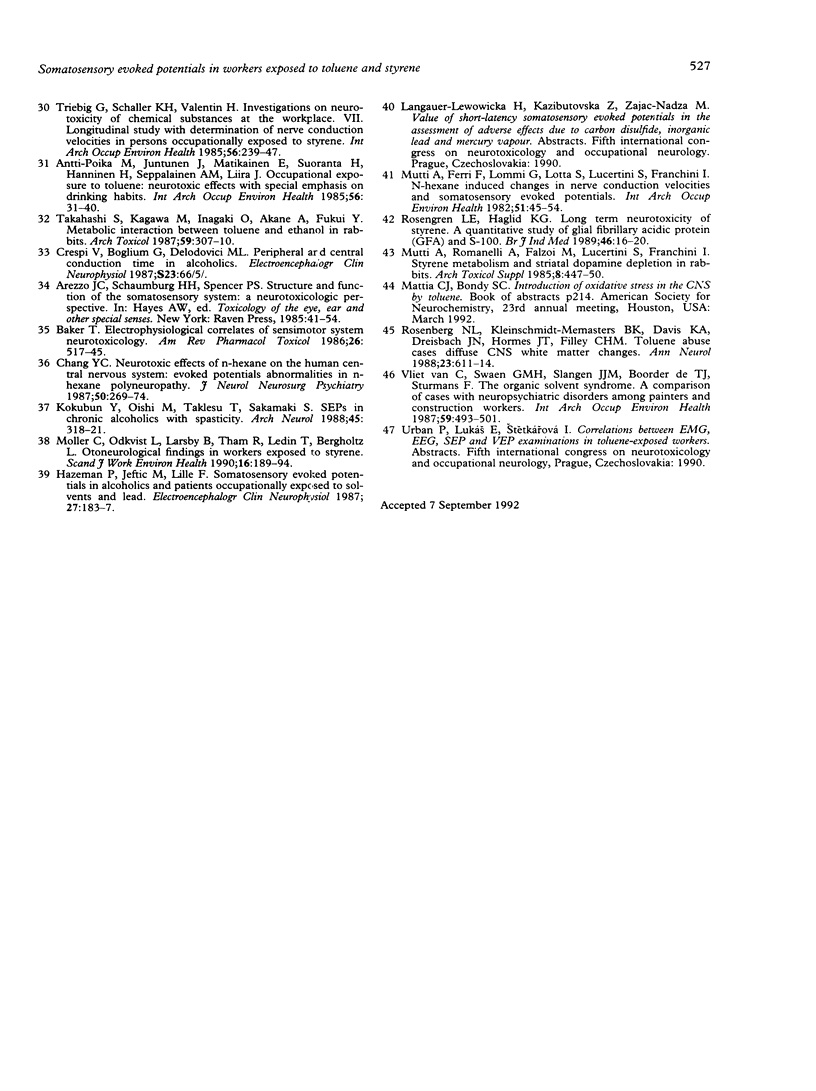
Selected References
These references are in PubMed. This may not be the complete list of references from this article.
- Allison T., Wood C. C., Goff W. R. Brain stem auditory, pattern-reversal visual, and short-latency somatosensory evoked potentials: latencies in relation to age, sex, and brain and body size. Electroencephalogr Clin Neurophysiol. 1983 Jun;55(6):619–636. doi: 10.1016/0013-4694(83)90272-9. [DOI] [PubMed] [Google Scholar]
- Antti-Poika M., Juntunen J., Matikainen E., Suoranta H., Hänninen H., Seppäläinen A. M., Liira J. Occupational exposure to toluene: neurotoxic effects with special emphasis on drinking habits. Int Arch Occup Environ Health. 1985;56(1):31–40. doi: 10.1007/BF00380698. [DOI] [PubMed] [Google Scholar]
- Antti-Poika M., Ojala M., Matikainen E., Vaheri E., Juntunen J. Occupational exposure to solvents and cerebellar, brainstem and vestibular functions. Int Arch Occup Environ Health. 1989;61(6):397–401. doi: 10.1007/BF00381031. [DOI] [PubMed] [Google Scholar]
- Arezzo J. C., Simson R., Brennan N. E. Evoked potentials in the assessment of neurotoxicity in humans. Neurobehav Toxicol Teratol. 1985 Jul-Aug;7(4):299–304. [PubMed] [Google Scholar]
- Baelum J., Lundqvist G. R., Mølhave L., Andersen N. T. Human response to varying concentrations of toluene. Int Arch Occup Environ Health. 1990;62(1):65–71. doi: 10.1007/BF00397850. [DOI] [PubMed] [Google Scholar]
- Baker E. L., Jr, Smith T. J., Landrigan P. J. The neurotoxicity of industrial solvents: a review of the literature. Am J Ind Med. 1985;8(3):207–217. doi: 10.1002/ajim.4700080306. [DOI] [PubMed] [Google Scholar]
- Baker T., Lowndes H. E. Electrophysiological correlates of sensorimotor system neurotoxicology. Annu Rev Pharmacol Toxicol. 1986;26:517–545. doi: 10.1146/annurev.pa.26.040186.002505. [DOI] [PubMed] [Google Scholar]
- Chang Y. C. Neurotoxic effects of n-hexane on the human central nervous system: evoked potential abnormalities in n-hexane polyneuropathy. J Neurol Neurosurg Psychiatry. 1987 Mar;50(3):269–274. doi: 10.1136/jnnp.50.3.269. [DOI] [PMC free article] [PubMed] [Google Scholar]
- Cherry N., Gautrin D. Neurotoxic effects of styrene: further evidence. Br J Ind Med. 1990 Jan;47(1):29–37. doi: 10.1136/oem.47.1.29. [DOI] [PMC free article] [PubMed] [Google Scholar]
- Chu N. S., Hong C. T. Erb's and cervical somatosensory evoked potentials: correlations with body size. Electroencephalogr Clin Neurophysiol. 1985 Sep;62(5):319–322. doi: 10.1016/0168-5597(85)90039-5. [DOI] [PubMed] [Google Scholar]
- Dyer R. S. The use of sensory evoked potentials in toxicology. Fundam Appl Toxicol. 1985 Feb;5(1):24–40. [PubMed] [Google Scholar]
- Hazemann P., Jeftic M., Lille F. Somatosensory evoked potentials in alcoholics and patients occupationally exposed to solvents and lead. Electromyogr Clin Neurophysiol. 1987 Apr-May;27(3):183–187. [PubMed] [Google Scholar]
- Hume A. L., Cant B. R., Shaw N. A., Cowan J. C. Central somatosensory conduction time from 10 to 79 years. Electroencephalogr Clin Neurophysiol. 1982 Jul;54(1):49–54. doi: 10.1016/0013-4694(82)90230-9. [DOI] [PubMed] [Google Scholar]
- Juntunen J., Matikainen E., Antti-Poika M., Suoranta H., Valle M. Nervous system effects of long-term occupational exposure to toluene. Acta Neurol Scand. 1985 Nov;72(5):512–517. doi: 10.1111/j.1600-0404.1985.tb00909.x. [DOI] [PubMed] [Google Scholar]
- Kokubun Y., Oishi M., Takasu T., Sakamaki S. Somatosensory evoked potentials in chronic alcoholics with spasticity. Arch Neurol. 1988 Mar;45(3):318–321. doi: 10.1001/archneur.1988.00520270100027. [DOI] [PubMed] [Google Scholar]
- Kovarík J., Pithartová R., Ehler E., Salandová J., Kuzelová M., Popler A., Sírl J., Ciharová M. Zdravotní stav pracovníků exponovaných styrénu pri výrobe skelných laminátů. Sb Ved Pr Lek Fak Karlovy Univerzity Hradci Kralove Suppl. 1989;32(5):617–624. [PubMed] [Google Scholar]
- Mattsson J. L., Gorzinski S. J., Albee R. R., Zimmer M. A. Evoked potential changes from 13 weeks of simulated toluene abuse in rats. Pharmacol Biochem Behav. 1990 Jul;36(3):683–689. doi: 10.1016/0091-3057(90)90274-l. [DOI] [PubMed] [Google Scholar]
- Mutti A., Ferri F., Lommi G., Lotta S., Lucertini S., Franchini I. n-Hexane-induced changes in nerve conduction velocities and somatosensory evoked potentials. Int Arch Occup Environ Health. 1982;51(1):45–54. doi: 10.1007/BF00378409. [DOI] [PubMed] [Google Scholar]
- Mutti A., Romanelli A., Falzoi M., Lucertini S., Franchini I. Styrene metabolism and striatal dopamine depletion in rabbits. Arch Toxicol Suppl. 1985;8:447–450. doi: 10.1007/978-3-642-69928-3_101. [DOI] [PubMed] [Google Scholar]
- Möller C., Odkvist L., Larsby B., Tham R., Ledin T., Bergholtz L. Otoneurological findings in workers exposed to styrene. Scand J Work Environ Health. 1990 Jun;16(3):189–194. doi: 10.5271/sjweh.1795. [DOI] [PubMed] [Google Scholar]
- Rebert C. S. Multisensory evoked potentials in experimental and applied neurotoxicology. Neurobehav Toxicol Teratol. 1983 Nov-Dec;5(6):659–671. [PubMed] [Google Scholar]
- Rosenberg N. L., Kleinschmidt-DeMasters B. K., Davis K. A., Dreisbach J. N., Hormes J. T., Filley C. M. Toluene abuse causes diffuse central nervous system white matter changes. Ann Neurol. 1988 Jun;23(6):611–614. doi: 10.1002/ana.410230614. [DOI] [PubMed] [Google Scholar]
- Rosén I., Haeger-Aronsen B., Rehnström S., Welinder H. Neurophysiological observations after chronic styrene exposure. Scand J Work Environ Health. 1978;4 (Suppl 2):184–194. [PubMed] [Google Scholar]
- Seppäläinen A. M., Härkönen H. Neurophysiological findings among workers occupationally exposed to styrene. Scand J Work Environ Health. 1976 Sep;2(3):140–146. doi: 10.5271/sjweh.2810. [DOI] [PubMed] [Google Scholar]
- Seppäläinen A. M., Laine A., Salmi T., Riihimäki V., Verkkala E. Changes induced by short-term xylene exposure in human evoked potentials. Int Arch Occup Environ Health. 1989;61(7):443–449. doi: 10.1007/BF00386477. [DOI] [PubMed] [Google Scholar]
- Seppäläinen A. M., Savolainen K., Kovala T. Changes induced by xylene and alcohol in human evoked potentials. Electroencephalogr Clin Neurophysiol. 1981 Feb;51(2):148–155. doi: 10.1016/0013-4694(81)90003-1. [DOI] [PubMed] [Google Scholar]
- Takahashi S., Kagawa M., Inagaki O., Akane A., Fukui Y. Metabolic interaction between toluene and ethanol in rabbits. Arch Toxicol. 1987 Feb;59(5):307–310. doi: 10.1007/BF00295080. [DOI] [PubMed] [Google Scholar]
- Triebig G. Occupational neurotoxicology of organic solvents and solvent mixtures. Neurotoxicol Teratol. 1989 Nov-Dec;11(6):575–578. doi: 10.1016/0892-0362(89)90040-8. [DOI] [PubMed] [Google Scholar]
- Triebig G., Schaller K. H., Valentin H. Investigations on neurotoxicity of chemical substances at the workplace. VII. Longitudinal study with determination of nerve conduction velocities in persons occupationally exposed to styrene. Int Arch Occup Environ Health. 1985;56(3):239–247. doi: 10.1007/BF00396601. [DOI] [PubMed] [Google Scholar]
- Zegers de Beyl D., Delberghe X., Herbaut A. G., Brunko E. The somatosensory central conduction time: physiological considerations and normative data. Electroencephalogr Clin Neurophysiol. 1988 Jan-Feb;71(1):17–26. doi: 10.1016/0168-5597(88)90015-9. [DOI] [PubMed] [Google Scholar]
- van Vliet C., Swaen G. M., Slangen J. J., de Boorder T., Sturmans F. The organic solvent syndrome. A comparison of cases with neuropsychiatric disorders among painters and construction workers. Int Arch Occup Environ Health. 1987;59(5):493–501. doi: 10.1007/BF00377844. [DOI] [PubMed] [Google Scholar]


